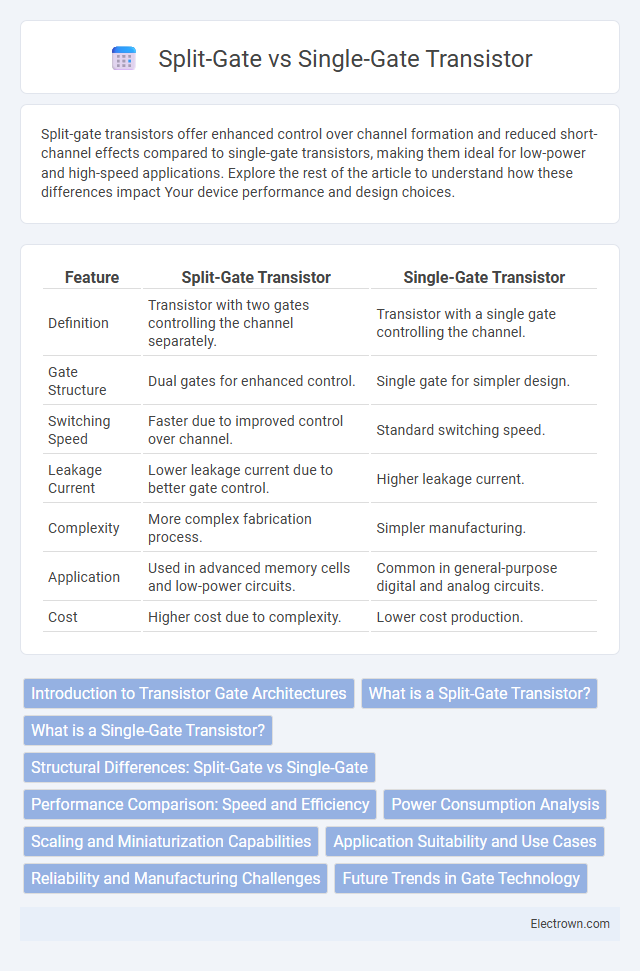Split-gate transistors offer enhanced control over channel formation and reduced short-channel effects compared to single-gate transistors, making them ideal for low-power and high-speed applications. Explore the rest of the article to understand how these differences impact Your device performance and design choices.
Table of Comparison
| Feature | Split-Gate Transistor | Single-Gate Transistor |
|---|---|---|
| Definition | Transistor with two gates controlling the channel separately. | Transistor with a single gate controlling the channel. |
| Gate Structure | Dual gates for enhanced control. | Single gate for simpler design. |
| Switching Speed | Faster due to improved control over channel. | Standard switching speed. |
| Leakage Current | Lower leakage current due to better gate control. | Higher leakage current. |
| Complexity | More complex fabrication process. | Simpler manufacturing. |
| Application | Used in advanced memory cells and low-power circuits. | Common in general-purpose digital and analog circuits. |
| Cost | Higher cost due to complexity. | Lower cost production. |
Introduction to Transistor Gate Architectures
Single-gate transistors feature a solitary gate electrode controlling the channel, providing simpler fabrication and standard performance in most digital circuits. Split-gate transistors incorporate two separate gate electrodes managing different channel regions, enabling enhanced control over short-channel effects and improving device scalability. Your choice between split-gate and single-gate architectures impacts transistor performance parameters such as threshold voltage, leakage current, and switching speed.
What is a Split-Gate Transistor?
A Split-Gate Transistor features two independent gates controlling the channel, enabling enhanced control over current flow and improved device performance compared to Single-gate Transistors, which have only one gate. This configuration reduces short-channel effects and leakage currents, making Split-Gate Transistors ideal for advanced memory and digital logic applications. The separated gates allow precise modulation of the channel charge, improving scalability and reliability in nanoscale semiconductor devices.
What is a Single-Gate Transistor?
A single-gate transistor is a fundamental semiconductor device that uses one gate electrode to control the flow of current between the source and drain terminals. It operates by modulating the channel conductivity through an electric field applied to the gate, enabling switching and amplification functions in integrated circuits. Single-gate transistors are widely used in CMOS technology due to their simple structure and reliable performance in digital and analog applications.
Structural Differences: Split-Gate vs Single-Gate
Split-gate transistors feature two separate gate electrodes controlling different regions of the channel, enhancing control over electron flow and reducing short-channel effects compared to single-gate transistors. Single-gate transistors utilize one continuous gate electrode over the channel, providing simpler fabrication but less precise electrostatic control. Your choice between split-gate and single-gate depends on the trade-offs between device complexity and performance in nanoscale applications.
Performance Comparison: Speed and Efficiency
Split-gate transistors offer enhanced control over channel conductivity, resulting in faster switching speeds and improved energy efficiency compared to single-gate transistors. The dual-gate design reduces short-channel effects and leakage currents, thereby boosting overall device performance in high-speed applications. Your choice of transistor impacts circuit speed and power consumption, making split-gate devices ideal for advanced low-power, high-frequency electronics.
Power Consumption Analysis
Split-gate transistors reduce power consumption by minimizing leakage currents through enhanced control of the channel compared to single-gate transistors. Your circuits benefit from the split-gate architecture's ability to lower subthreshold leakage, resulting in improved energy efficiency for low-power applications. Single-gate transistors, while simpler, typically exhibit higher standby power due to less effective gate control and increased short-channel effects.
Scaling and Miniaturization Capabilities
Split-gate transistors offer enhanced scaling and miniaturization capabilities compared to single-gate transistors by providing better control over the channel through multiple gates, which reduces short-channel effects and leakage currents. This improved electrostatic control allows split-gate devices to maintain performance at smaller dimensions, enabling further device scaling in advanced semiconductor technologies. Single-gate transistors face challenges with gate control and leakage as dimensions shrink, limiting their effectiveness in ultra-scaled applications.
Application Suitability and Use Cases
Split-gate transistors offer enhanced control over channel formation, making them ideal for non-volatile memory applications such as flash memory where precise charge trapping is crucial. Single-gate transistors provide simpler design and lower fabrication costs, suiting digital logic circuits and general-purpose amplification in integrated circuits. The distinct gate configurations influence their suitability, with split-gate devices favored in specialized memory architectures and single-gate devices prevalent in mainstream CMOS technology.
Reliability and Manufacturing Challenges
Split-gate transistors offer enhanced reliability due to their improved control over short-channel effects, reducing leakage currents and boosting device stability compared to single-gate transistors. Manufacturing challenges arise from the increased complexity in fabricating split-gate structures, requiring precise alignment and advanced lithography techniques, which can impact yield and cost efficiency. Your choice between these transistor types depends on balancing the need for reliability with the feasibility of scalable production processes in semiconductor manufacturing.
Future Trends in Gate Technology
Split-gate transistors offer enhanced control over short-channel effects and reduced leakage currents compared to traditional single-gate transistors, making them a promising candidate for future nanoscale devices. Emerging trends in gate technology emphasize multi-gate architectures like split-gate designs to boost transistor performance, scalability, and energy efficiency in next-generation integrated circuits. Your choice of gate structure could significantly impact device reliability and power consumption as semiconductor technology continues to evolve toward smaller nodes.
Split-gate vs Single-gate transistor Infographic

 electrown.com
electrown.com